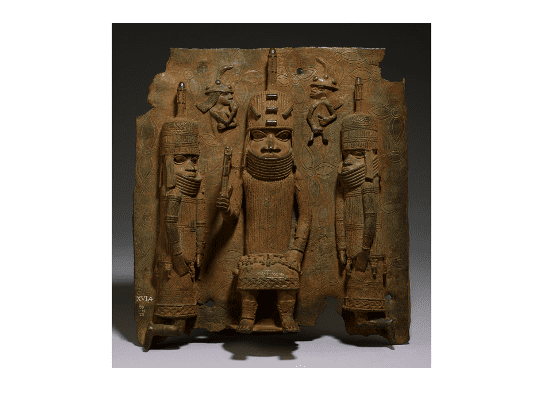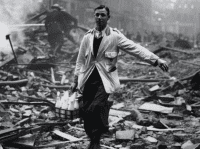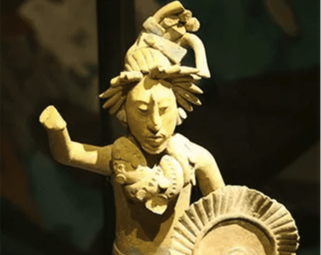
When teaching this unit, you are advised to use the medium-term planner in the planning section which links the learning strategies directly to specific well-chosen objectives which are pitched at the right age group, in this case Y5. The lessons and smart tasks are based on 6 motivating key questions, designed to bring out the central historical skills and concepts related to this topic, as well as ideas for a home study and assessment task. The learning is built up progressively as the topic develops, until towards the end of the topic when pupil’s deeper understanding is assessed. Whilst we have provided a comprehensive guide we have also left enough space for you to diamond polish the whole scheme by adding your own ideas.
Image of Oba’s procession in Benin © The Salariya Book Company
Lessons/Smart Tasks
- Why do YOU think we should study Benin in school?Key Question 1 SMART TASK After setting Benin in its context of place and time, pupils tour a gallery of images which give them hints as to why Benin might be a significant society, worthy of study. Having pooled their emerging ideas they are given 10 assertions as to why they are important. Pupils then have to place these on a spectrum of significance before arriving at their considered answers.
- What sort of place was Benin 500 to 1,000 years ago? Key Question 2 SMART TASK Here pupils are introduced to the idea of a society from a distant time about which very little evidence remains. This can be frustrating for pupils who crave a clear picture of this past society. To make it come alive for them we have invested time in selecting some key artists’ illustrations and written descriptions which pupils need to draw on in order to have to design a time traveller’s tourist trail. The focus is on pupils creatively using their three senses: sound, sight and smell. They must give advice to potential visitors telling them what to wear.
- What can we tell about Benin society at this time from the images and artefacts that have survived? Key Question 3 This lesson revolves round four principal activities: Fastest Finger First; Mining for meaning, using an artist’s illustration; Call My Bluff which creatively uses images of mystery objects; and Curator’s dilemma. The emphasis is on looking at a range of evidence and drawing tentative conclusions from it.
- Why did the Victorians get involved in Benin and what were the effects on the Benin people? Key Question 5 SMART TASK Following an intriguing slow reveal of an interesting Victorian photograph showing the capture of the Oda’s palace in Benin, pupils create their own living graph to show Benin’s changing fortunes during the frantic decade of the 1890s. They then look for three key turning points in the story of how and why Benin became absorbed into the British Empire. The session then links neatly to the next lesson – Should the bronzes taken in 1897 be returned ?
- Should the Benin Bronzes be returned? Key Question 6 SMART TASK This lesson is guaranteed to provoke a lively debate. Armed with all the contextual knowledge they need, and stimulated by some thought-provoking quotations, pupils work in teams to advocate a particular course of action. By way of preparation, they have to speculate as to likely arguments first before being given some ‘influence cards’ to deepen their thinking.
Important note: Resourcing individual lessons and smart tasks. Many of you have kindly complimented the planning we have provided for all the new KS2 topics. We’re pleased that you have found it helpful. You will notice that we have tried to show the nature of all the activities and accompanying resources necessary to meet the learning objectives. This does not mean that all the resources are immediately ready to download and use: we are developing and refining them as we trial them. For all of us, these topics are very new and only gradually are quality resources emerging. OFSTED knows this. So please be patient. We don’t want to upload mediocre material for the sake of having something there. We very much follow General Patten’s dictum “ Never tell people how to do things. Tell them what to do and they will surprise you with their ingenuity”. Our planning strongly follows this approach. But if you are stuck and would like to see examples of what we are thinking of in terms of lessons activities and resources, then we are prepared to email you draft material in an unfinished state for you to refine. After all, a good resource only becomes a great one when you modify it for your pupils.
Why should I choose Benin?
- A recent UK census showed that more than 5% of Londoners were of black African descent.
- There are some great artefacts, the Benin bronzes for pupils to study: intriguing objects of international importance.
- It is a wonderful example of an African society producing superb works of art that those who discovered them thought must have been from Ancient Egypt. The idea that Africa could be producing the quality of sculpture usually associated with renaissance Europe serves as a wonderful counterweight to the cultural chauvinism shown in the west.
- The story of Africa’s relationship with Europe is an important one for pupils to know.
- The trajectory of this unit enables pupils to look at European actions through African eyes, thereby building their empathetic understanding.
Resources
The BBC has recently broadcast a short film about Benin about 500 years ago You can find it here. http://www.bbc.co.uk/programmes/p02m8908
It is described by the BBC as follows: Benin is famous for its bronzes. This film explores how they are made, using the ‘lost wax’ process, and why. The people of Benin traded as far away as India and throughout the whole of Africa, and when the Portuguese arrived in the late C15th they began trading with Europe. Benin city was one of the largest cities in Africa. Each trade had its own district; there was even a storytellers’ district!
Excellent background reading on all aspects of Benin’s history and culture http://www.britishmuseum.org/pdf/KingdomOfBenin_TeachersNotes.pdf
BBC website resource link: http://www.bbc.co.uk/schools/primaryhistory/worldhistory/benin_bronze/
To access the entire site including resources and lesson plans for teaching at Key Stage 2, subscribe below







